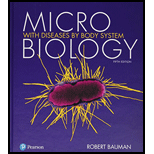
Microbiology with Diseases by Body System (5th Edition)
5th Edition
ISBN: 9780134477206
Author: Robert W. Bauman Ph.D.
Publisher: PEARSON
expand_more
expand_more
format_list_bulleted
Question
Chapter 10, Problem 7MC
Summary Introduction
Introduction:
Drugs that are used to treat the microbial infections are commonly referred to as antimicrobial agents. Antimicrobial agents differ in their mode of action, including the inhibitions of cell wall, protein and
Expert Solution & Answer
Want to see the full answer?
Check out a sample textbook solution
Students have asked these similar questions
help tutor please
Q8. A researcher wants to study the effectiveness of a pill intended to reduce stomach heartburn in pregnant
women. The researcher chooses randomly 400 women to participate in this experiment for 9 months of their
pregnancy period. They all need to have the same diet. The researcher designs two groups of 200 participants:
One group take the real medication intended to reduce heartburn, while the other group take placebo
medication. In this study what are:
Independent variable:
Dependent variable:
Control variable:
Experimental group: "
Control group:
If the participants do not know who is consuming the real pills and who is consuming the sugar pills.
This study is
It happens that 40% of the participants do not find the treatment helpful and drop out after 6 months.
The researcher throws out the data from subjects that drop out. What type of bias is there in this study?
If the company who makes the medication funds this research, what type of bias might exist in this
research work?
How do I determine the inhertiance pattern from the pedigree diagram?
Chapter 10 Solutions
Microbiology with Diseases by Body System (5th Edition)
Ch. 10 - Prob. 1TMWCh. 10 - Some antimicrobial drugs are harmful to humans....Ch. 10 - Antibiotic Overkill A young woman was taking...Ch. 10 - Prob. 2CCSCh. 10 - Prob. 3TMWCh. 10 - Why is it incorrect to say that an individual...Ch. 10 - Prob. 1EDCSCh. 10 - Prob. 3CCSCh. 10 - Prob. 1MCCh. 10 - In a Kirby-Bauer susceptibility test, the presence...
Ch. 10 - Prob. 3MCCh. 10 - Prob. 4MCCh. 10 - Cross resistance is _____. a. the deactivation of...Ch. 10 - Prob. 6MCCh. 10 - Prob. 7MCCh. 10 - Prob. 8MCCh. 10 - Prob. 9MCCh. 10 - Prob. 10MCCh. 10 - Label each figure below to indicate the class of...Ch. 10 - What specific test for antimicrobial efficacy is...Ch. 10 - What characteristics would an ideal...Ch. 10 - Prob. 2SACh. 10 - Why is the fact that drug Z destroys the NAM...Ch. 10 - Given that both human cells and pathogens...Ch. 10 - Prob. 5SACh. 10 - Prob. 6SACh. 10 - Prob. 7SACh. 10 - Prob. 8SACh. 10 - Compare and contrast the actions of polyenes,...Ch. 10 - Prob. 10SACh. 10 - Prob. 1CTCh. 10 - How does Penicillium escape the effects of the...Ch. 10 - How might a colony of Bacillus licheniformis...Ch. 10 - Fewer than 1 % of known antibiotics have any...Ch. 10 - In an issue of News of the Lepidopterists Society,...Ch. 10 - Even though aminoglycosides such as gentamicin can...Ch. 10 - Prob. 7CTCh. 10 - Prob. 8CTCh. 10 - Why might amphotericin B affect the kidneys more...Ch. 10 - Antiparasitic drugs in the benzimidazole family...Ch. 10 - Prob. 11CTCh. 10 - Scientists have cultured bacteria isolated from...Ch. 10 - Prob. 13CTCh. 10 - Prob. 14CTCh. 10 - Enterococcus faecium is frequently resistant to...Ch. 10 - Prob. 1CM
Knowledge Booster
Similar questions
- 22. Which of the following mutant proteins is expected to have a dominant negative effect when over- expressed in normal cells? a. mutant PI3-kinase that lacks the SH2 domain but retains the kinase function b. mutant Grb2 protein that cannot bind to RTK c. mutant RTK that lacks the extracellular domain d. mutant PDK that has the PH domain but lost the kinase function e. all of the abovearrow_forwardWhat is the label ?arrow_forwardCan you described the image? Can you explain the question as well their answer and how to get to an answer to an problem like this?arrow_forward
- Describe the principle of homeostasis.arrow_forwardExplain how the hormones of the glands listed below travel around the body to target organs and tissues : Pituitary gland Hypothalamus Thyroid Parathyroid Adrenal Pineal Pancreas(islets of langerhans) Gonads (testes and ovaries) Placentaarrow_forwardWhat are the functions of the hormones produced in the glands listed below: Pituitary gland Hypothalamus Thyroid Parathyroid Adrenal Pineal Pancreas(islets of langerhans) Gonads (testes and ovaries) Placentaarrow_forward
arrow_back_ios
SEE MORE QUESTIONS
arrow_forward_ios
Recommended textbooks for you
- Essentials of Pharmacology for Health ProfessionsNursingISBN:9781305441620Author:WOODROWPublisher:Cengage
- Basic Clinical Lab Competencies for Respiratory C...NursingISBN:9781285244662Author:WhitePublisher:Cengage


Essentials of Pharmacology for Health Professions
Nursing
ISBN:9781305441620
Author:WOODROW
Publisher:Cengage




Basic Clinical Lab Competencies for Respiratory C...
Nursing
ISBN:9781285244662
Author:White
Publisher:Cengage